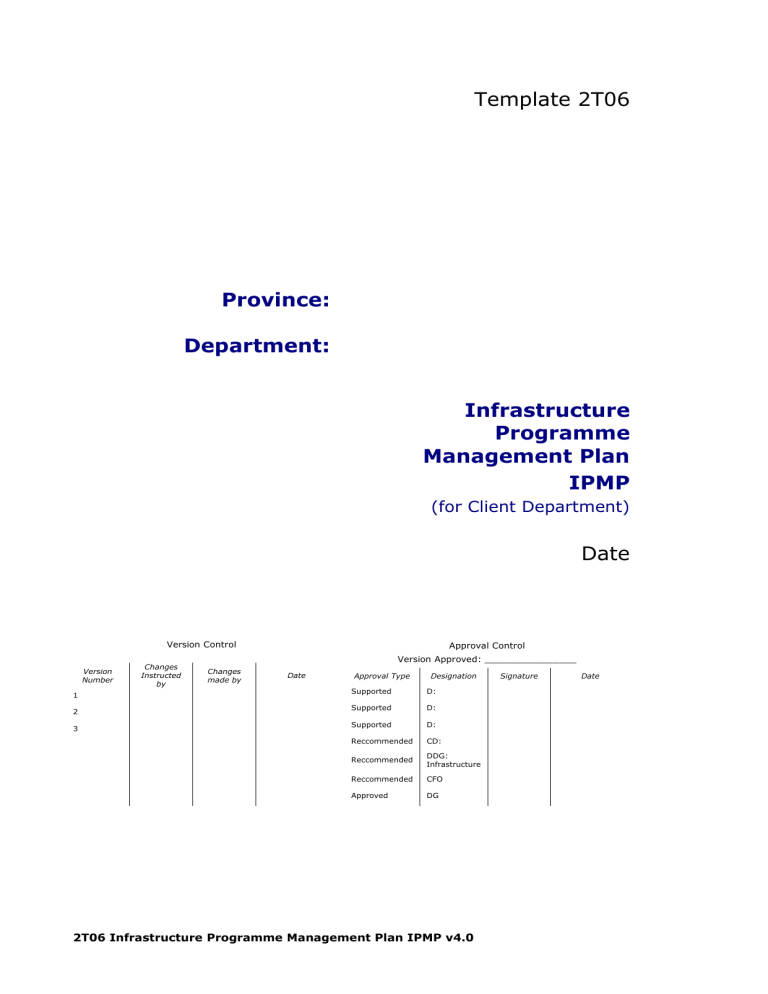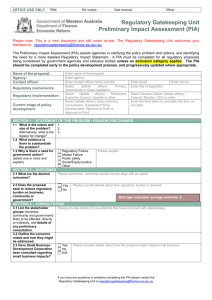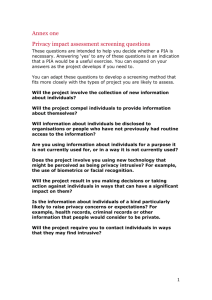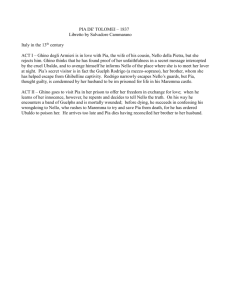Infrastructure Programme Management Plan (IPMP)

Template 2T06
Province:
Department:
Infrastructure
Programme
Management Plan
IPMP
(for Client Department)
Date
3
1
2
Version
Number
Version Control
Changes
Instructed by
Changes made by
Date
Approval Control
Version Approved: ________________
Signature Approval Type
Supported
Supported
Designation
D:
D:
Date
Supported D:
Reccommended CD:
Reccommended
DDG:
Infrastructure
Reccommended CFO
Approved DG
2T06 Infrastructure Programme Management Plan IPMP v4.0
Table of Contents
1
2
Executive Summary
Background
2.1
Description of Concepts
2.2
Context
2.3
IPMP Document Structure
3 Programme Objectives
3.1
Linkage to Provincial Growth and Development Plan
3.2
Linkage to Departmental Strategic Plan
3.3
Programme LogFrame
3.4
Development Objectives
4 Programme Implementation Assignment
4.1
Programme Scope Overview
4.1.1
Sub-Programme Breakdown and Assignment Approach
4.2
Sub-Programme 1 (PIA 1) Specific Programme Scope Assignment (PIA Specific)
4.2.1
Sub-Programme Scope
4.2.2
Sub-Programme Implementation Constraints and Assumptions
4.2.3
Sub-Programme Implementation Organisation Requirements
4.2.4
Initial Identified Sub-Programme Risks
9
9
9
10
4.3
Sub-Programme 2 (PIA B) Specific Programme Scope Assignment (PIA Specific) (etc)10
4.4
General Sub-Programme Requirements (Non PIA Specific)
4.4.1
Infrastructure Programme Implementation Planning Requirements
10
10
4.4.2
Programme Monitoring and Controlling Requirements
4.4.3
Programme Reporting Requirements
4.4.4
Programme Quality Requirements
4.4.5
Programme Procurement Requirements
4.4.6
Programme Environmental Requirements
4.4.7
Programme Health and Safety Requirements
5 Internal (Client Side) Programme Management Plan
5.1
Programme Institutional Framework
5.1.1
Programme Structure
5.1.2
Programme Roles and responsibilities
5.1.3
Responsibilities of the Client Programme Office
5.1.4
Roles within the Client Programme Management Team
5.1.5
Responsibilities of the Programme Implementing Agent (PIA)
5.1.6
Programme Contractual Arrangements
5.2
Programme Integration Management
5.2.1
Programme Management System, Process and Procedures
5.2.2
Integrated Programme Change Control
5.3
Infrastructure Programme Timelines and Milestones
5.4
Programme Financial Management
15
15
15
15
18
12
12
13
14
10
10
11
11
10
10
10
10
11
12
7
7
8
8
8
9
9
6
7
7
4
4
4
6
2T06 Infrastructure Programme Management Plan IPMP v4.0
5.4.1
Programme Funding management
5.4.2
Programme Cost Management
5.5
Programme Quality Management
5.5.1
Responsibility:
5.6
Programme Performance Management
5.6.1
Progress and Performance Monitoring
5.6.2
Key Performance Indicators
5.6.3
External Evaluation
5.7
Programme Reporting
5.7.1
Reports
5.8
Programme Communication Management
5.8.1
Objectives
5.8.2
Communications Plan Structure
5.8.3
Responsibility:
5.9
Programme Risk Management
5.9.1
Responsibility:
5.10
Human Resources Plan
5.11
Programme Procurement Management
Appendix A
Appendix B
Table of Figures
19
20
21
21
22
23
23
24
24
24
25
25
26
26
18
18
18
18
19
19
Table of Tables
2T06 Infrastructure Programme Management Plan IPMP v4.0
1 Executive Summary
The Executive Summary should emphasise the key issues contained in the body of the plan and provide readers with a succinct overview of the entire plan. Some readers who are not concerned with the finer details of the plan may only read the summary.
2
2.1
Background
Description of Concepts
The following concepts are used in this document 1 :
Concept Description
Infrastructure Plan
IDIP
The Infrastructure Plan is a formally approved document prepared by the Client Department detailing over the medium and long term how the infrastructure required by the department to deliver its mandated services will be acquired, rehabilitated, maintained and funded.
The Infrastructure Delivery Improvement
Programme (IDIP) is a National programme with the objective of Improving the effectiveness and efficiency of delivery of provincial public sector infrastructure through institutionalising best practice tools and building capacity.
IPMP The Infrastructure Programme Management Plan is a formal approved document prepared by the Client
Department that specifies how the infrastructure programme will be executed, monitored and controlled over the current MTEF period.
If all or part of the implementation is assigned to one or more Implementing Agents, the IPMP defines
1
For more detail please refer to the IDIP Toolkit
2T06 Infrastructure Programme Management Plan IPMP v4.0
IPIP
Client Department
Implementing Agent
SDA the scope deliverables, targets and requirements of the sub-programmes assigned to specific
Implementing Agents
The Infrastructure Programme Implementation Plan is a formal approved document prepared by the
Implementing Agent in response to the subprogramme assigned to it through the IPMP
The Client Department is the Department mandated to delivery of a specific service such as Education,
Health, Transportation etc.
The Implementing Agent can be a Department of
Public Works or another organisation contracted by the Client Department to implement part or all of its
Infrastructure Programme.
The Service Delivery Agreement is a formally approved and signed contract between the Client
Department and the Implementing Agent defining the contractual relationships between the two parties in respect of the delivery of the programme scope defined in the relevant programme scope statements defined in the Client Department’s IPMP.
2T06 Infrastructure Programme Management Plan IPMP v4.0
2.2
Context
5 Year
Strategic
Plan
Infrastructure
Plan
MTEF
Window
Org &
Support
Plan
Long
Term
Budget
3 Year MTEF
Infrastructure Budget
3 Year MTEF
Org & Support Budget
Service Delivery Agreement
Infrastructure Programme
Management Plan
(IPMP)
Infrastructure Programme
Implementation Plan(s)
(IPIP)
Project
Execution
Plans (PEPs)
Figure 1: Context of the IPMP in relation to other IDIP Documents
2.3
IPMP Document Structure
A short description of how the document is structured and the purpose of the Key Sections., e.g:
1 Executive Summary
2 Background to the plan – Discussion of the context and purpose of the plan
3 Infrastructure Programme Objectives for <Name of Department> <Name of Province> - discussion of the objectives of this programme, its linkages to the Provincial and
2T06 Infrastructure Programme Management Plan IPMP v4.0
Departmental Strategic Plans and its Developmental Objectives. This is also the ideal place to refer to the Programme objectives through the high level Programme Logical Framework.
4 Programme Implementation Assignments – This section covers the approach to and detail of breaking up of the Programme into Sub-Programmes and the assignment of subprogrammes to implementing agents, complete with detail on programme management requirements and project pre-conditions.
5 Internal (Client Side) Programme Management Plan - This section of the plan deals with the internal programme management issues, such as programme team structures, programme management systems, process and procedures and contains sub-plans dealing with financial, quality, performance, communication, reporting, risk and procurement aspects.
3
3.1
3.2
Programme Objectives
Linkage to Provincial Growth and Development Plan
Summarise the key linkages to the PGDP with specific reference to Key Performance Indicators relevant to the programme required at a Provincial level.
Linkage to Departmental Strategic Plan
Summarise the key linkages to the PGDP with specific reference to Key Performance Indicators relevant to the programme required at a Provincial level.
3.3
Programme LogFrame
Include the High level Programme LogFrame in this section and cross reference to the detail
LogFrame in an Appendix. The Logframe will serve to tie in this IPMP with the goals and objectives of the IDIP as well as Provincial and departmental Goals and objectives.
2T06 Infrastructure Programme Management Plan IPMP v4.0
Programme Name
Intervention logic
Overall Logical Framework for Programme Phase - - year
Objectively verifiable indicators
Goal
Improved effectiveness & efficiency of delivery of provincial public sector infrastructure through institutionalising best practice tools and building capacity
Purpose
Ouputs
Activities
Table 1: Programme Objectives in Logical Framework Format
3.4
Date Updated:
Means of verification
Page 8 of n
Assumptions
Development Objectives
Specific reference to the Developmental objectives of the programme and the approach to meeting these objectives. Programme Implementation Assignment
3.5
Programme Scope Overview
Total Infrastructure project cost per Category and Sub-
Programme
MTEF Year 1
(Year of
Implementation)
2005/06
MTEF Year 2 MTEF Year 3 MTEF Year 4 MTEF Year 5
No.
Category and Sub-Programme Assigned to PIA 2006/07 2007/08 2008/09 2009/10
Total Infrastructure project cost
R'000 R'000 R'000 R'000 R'000
550 000 577 500 606 375 511 667 537 250
1 New Construction / Acquisition
1.1
Sub- Programme 1.1
1.2
Sub- Programme 1.2
1.3
Sub- Programme 1.3
2 Rehabilitaion
2.1
Sub-Programme 2.1
2.2
Sub-Programme 2.2
2.3
Sub-Programme 2.3
3 Maintenance
3.1
Sub-Programme 3.1
3.2
Sub-Programme 3.2
4 Feasibility, Planning and Design
4.0
Cross Cutting
4.1
PIA A Sub-Progarmme
4.2
PIA B Sub-Progarmme
4.3
PIA C Sub-Progarmme
5 Organisation and Support
5.0
Cross Cutting
5.1
PIA A Sub-Progarmme
5.2
PIA B Sub-Progarmme
5.3
PIA C Sub-Progarmme
PIA A
PIA A
PIA B
PIA B
PIA C
PIA C
270 000 283 500 297 675 219 949 230 946
100 000 105 000 110 250 115 763 121 551
90 000 94 500 99 225 104 186 109 396
80 000 84 000 88 200
65 000 68 250 71 663 46 305 48 620
30 000 31 500 33 075 34 729 36 465
25 000 26 250 27 563
10 000 10 500 11 025 11 576 12 155
140 000 147 000 154 350 162 068 170 171
PIA B
PIA C
80 000 84 000 88 200 92 610 97 241
60 000 63 000 66 150 69 458 72 930
48 000 50 400 52 920 55 566 58 344
Client Department 3 000 3 150 3 308 3 473 3 647
PIA A 18 000 18 900 19 845 20 837 21 879
PIA B
PIA C
18 000 18 900 19 845 20 837 21 879
9 000 9 450 9 923 10 419 10 940
27 000 28 350 29 768 27 780 29 169
Client Department 12 000 12 600 13 230 13 892 14 586
PIA A 5 000 5 250 5 513 5 788 6 078
PIA B
PIA C
6 000 6 300 6 615 4 800 5 040
4 000 4 200 4 410 3 300 3 465
Table 2: Summary of Infrastructure Expenditure by Category
2T06 Infrastructure Programme Management Plan IPMP v4.0
3.5.1
Sub-Programme Breakdown and Assignment Approach
Provide motivation why the programme is divided into specific sub-programmes and indicate linkage of these sub-programmes to strategic objectives. Also discuss motivations for assignment of sub-programmes to Implementing Agents as applicable. Discuss strengths and weaknesses ito technical competence and capacity
Total Infrastructure Cost Assignment per Organisation
MTEF Year 1
(Year of
Implementation)
MTEF Year 2 MTEF Year 3 MTEF Year 4 MTEF Year 5
Total Infrastructure Cost
2005/06 2006/07 2007/08 2008/09 2009/10
R'000 R'000 R'000 R'000 R'000
550 000 577 500 606 375 511 667 537 250
0
1
2
Client Department
PIA A
PIA B
15 000 15 750 16 538 17 364 18 233
213 000 223 650 234 833 246 574 258 903
214 000 224 700 235 935 152 976 160 625
3 PIA C 108 000 113 400 119 070 94 752 99 490
Table 3: Programme Assignment per Organisation
3.6
3.6.1
Sub-Programme 1 (PIA 1) Specific Programme Scope Assignment
(PIA Specific)
This sub-sectioned is aimed at a specific Programme Implementing Agent and contains detail of the programme and sub-programmes being assigned to that PIA only.
Sub-Programme Scope
The Scope of the projects assigned to the PIA is defined and described here. This section should include summary tables similar to those for the programme in section 4.1 above, with detailed project lists included in tables and spreadsheets attached in the appendices.
3.6.2
3.6.3
Any pre-conditions specific to projects identified during the infrastructure planning processes; specific design requirements; developmental targets such as Expanded Public Works
Development Programme targets; delivery dates and any other project specific requirements must be included with the project scope assignment detail.
Sub-Programme Implementation Constraints and Assumptions
In this section the Client Department will inform the PIA of any external constraints and or assumptions that need to be considered in the implementation of the specific sub-programme.
Sub-Programme Implementation Organisation Requirements
In this section the Client Department will inform the PIA of any specific requirements in respect of the Implementation Organisation.
2T06 Infrastructure Programme Management Plan IPMP v4.0
3.6.4
Initial Identified Sub-Programme Risks
In this section the client department will inform the PIA of any specific initial Risks that have been identified and which will require management.
3.7
Sub-Programme 2 (PIA B) Specific Programme Scope Assignment
(PIA Specific) (etc)
Ditto as above for any additional PIA’s
3.8
General Sub-Programme Requirements (Non PIA Specific)
In this section, the Client Department will provide general, non-PIA specific requirements in respect of the management of the implementation programme.
Describe each of the topics under the relevant headings below:
3.8.1
3.8.2
3.8.3
3.8.4
3.8.5
3.8.6
3.8.7
Infrastructure Programme Implementation Planning Requirements
Programme Monitoring and Controlling Requirements
Programme Reporting Requirements
Programme Quality Requirements
Programme Procurement Requirements
Programme Environmental Requirements
Programme Health and Safety Requirements
2T06 Infrastructure Programme Management Plan IPMP v4.0
4
4.1
4.1.1
Internal (Client Side) Programme Management Plan
Programme Institutional Framework
In these sections define the institutional arrangements, roles and responsibilities and contractual arrangements between the various stakeholders. A table of stakeholders and their
Programme Structure
Client
Department
Executive
Other
Programme
Stakeholders
Client Side
Infrastructure Programme
Management Office
Programme
Manager
Cost
Manager
Performance
Manager
Scope
Manager
Implementation Sub-
Programme (1)
Implementation Sub-
Programme (2)
Figure 2: Typical Client Programme Office Structure showing relationships with other programme elements
2T06 Infrastructure Programme Management Plan IPMP v4.0
4.1.2
Programme Roles and responsibilities
Sub Sub -
Figure 3: Programme Roles showing Lines of Authority
4.1.3
Responsibilities of the Client Programme Office
Contract with the PIA/s;
Provide policy regarding the programme;
Prioritise and approve projects and provide the PIAs with comprehensive Infrastructure
Programme Management Plans (IPMP) referring to the portions of the programmes allocated to them;
Review and approve the Infrastructure Programme Implementation Plans (IPIP)of the
PIA/s;
Monitor the performance and report progress of the overall programme;
Provide funding to PIAs in terms of the service delivery agreements with them;
Receive and sign off completed infrastructure;
Monitor the programme and performance of the PIA;
Approve payments to the PIA;
4.1.4
Roles within the Client Programme Management Team
Below are examples of roles of client side programme office team members. The exact requirements will vary from programme to programme.
4.1.4.1
Infrastructure Programme Manager
Carries overall responsibility for implementation of the Programme;
Accepts and understands the Infrastructure Plan which is to be implemented;
2T06 Infrastructure Programme Management Plan IPMP v4.0
Sub -
Facilitates the service delivery agreements with the PIA/s;
Develops the Infrastructure Programme Management Plan
Reviews and approves the PIA/s Infrastructure Programme Implementation Plan/s;
Manages overall programme management budgets and expenditure;
Reviews and reports on capital cash flow requirements;
Overall management of the Programme to delivery the infrastructure stipulated in the
Infrastructure Plan specifically in terms of scope, time, quality, risk and cost management;
Checks and approve payment certificates of the PIA/s;
Chairs coordination meetings with PIA/s;
Reviews PIA progress reports and provides overall reports for the Programme;
Manages progress through cash-flows;
Ensures that targets are met;
Ensures programme close-out;
Coordinates the handover of the completed projects from the PIA/s to the users within the
Department;
4.1.4.2
Financial Controller
Monitors overall performance of Programme with respect to cash flows and targets;
Prepares financial reports summarising project and Programme progress;
Manages financial aspects of scope changes;
Monitors programme management costs.
Reconciles programme payments;
Administers payment protocols and procedures;
Provides financial reports to the Programme Manager;
Administers Programme Finances.
4.1.4.3
Programme Administration Assistant
Captures programme data;
Captures and processes payment certificates of the PIA/s;
File correspondence between the department and the PIA/s;
General assistance to the programme manager as instructed;
4.1.5
Responsibilities of the Programme Implementing Agent (PIA)
Prepare and Submit a Infrastructure Programme Implementation Plan (IPIP) for approval by the Client ;
2T06 Infrastructure Programme Management Plan IPMP v4.0
Assume responsibilities for appointment and management of project managers;
Carry out feasibility assessments of all potential projects;
Appoint all professional service providers and contractors;
Ensure all appropriate insurances are in place to cover all potential risks;
Ensure that all professional service providers are covered by adequate professional indemnity insurances during the contract;
Receive and analyse assessment reports;
Receive and analyse cost reports and monitoring tools;
Set up adequate monitoring tools and suitably qualified personnel;
Monitor performance of contractors and service providers;
Prepare and submit monthly reports to the Client in the prescribed format;
Co ordinate, chair and minute coordination meetings and monitor progress;
Ensure timely payment of professional service providers and contractors;
Ensure compliance with Treasury requirements.
4.1.6
Programme Contractual Arrangements
Sub Sub Sub -
Figure 4: Contractual Relationships
Provide a short description of the contract between the Client Department and the PIA - the Service Delivery Agreement (SDA).
Define or Describe the Consultants Agreements to be used between the PIA and the various professional team members
2T06 Infrastructure Programme Management Plan IPMP v4.0
Define or Describe the Building or Construction Agreement to be used between the Main
Contractor and the PIA
Note, if the Client Department chooses not to use a PIA, then all contracts are entered into directly by the Client Department.
4.2
4.2.1
4.2.2
Programme Integration Management
Programme Management System, Process and Procedures
In this section define the various systems, processes and procedures that will be used to manage the direction and monitoring and control of programme work.
Integrated Programme Change Control
Changes to scope, cost, time and quality parameters on projects are inevitable. A change to any one of these parameters will have an impact on the others, and it is therefore essential that an integrated approach to change control be prescribed.
It is good practice to define a Change Control Board mandated to approve changes to individual projects. Authority to approve changes within defined limits can be delegated by the
CCB to the PIA and even down to Project level. It is however essential that all information in respect of changes be collated at a programme level.
4.3
Infrastructure Programme Timelines and Milestones
The synoptic programme for the Infrastructure Management Programme is set down in
A detailed schedule is attached as Appendix D of this document.
MILESTONE & SUB-MILESTONE
1 Annual Infrastructure Programme Management Plan established
1.1 Budget allocation confirmed
1.2 Projects selected (including identification, prioritisation, assessment and approval)
1.3 Programme Plan prepared
1.4 Programme Plan approved
REQUIRED OUTCOMES a. Infrastructure Programme Management Plan approved (including budget allocation and project approval)
2 Infrastructure Programme Mobilized
2.1 Programme management unit established and capacitated (required at the start of the programme and capacitation regarding any changes to the programme on the basis of policy changes and
TARGET DATE
2T06 Infrastructure Programme Management Plan IPMP v4.0
MILESTONE & SUB-MILESTONE improvements based on the evaluation of the previous programme
2.2 Implementing agents appointed (if agents are to be used) in terms of PIA/SLA agreements
2.3 Projects assigned to implementing agents
2.4 Forward planning defined (as required to effectively mobilize the projects to be implemented in future years)
REQUIRED OUTCOMES a.
Programme management in place and capacitated b.
Programme implementing agent agreements
(SLA/s) in place c.
Projects assigned to implementing agents d.
Forward planning for future years defined
3 Project Delivery – see table 4.2 for details of the project cycle
3.1 Scope of all projects confirmed
3.2 All projects set up (i.e. professional team appointed and project steering committee formed and empowered)
3.3 All projects planned, designed and tendered
3.4 All projects awarded
3.5 All projects constructed
3.6 All projects handed over for use
3.7 All projects completed (i.e. project documentation completed and construction contracts closed out)
3.8 Forward planning for following year completed (only if planning and design is to be carried out in the current year in order to accelerate project delivery within the next year)
REQUIRED OUTCOMES a.
All projects completed to specification within budget and agreed timeframe b.
Forward planning completed
4 Infrastructure Programme Completion
1.1
Programme evaluated (including evaluation of a sample of projects)
1.2
Programme completion report prepared
1.3
Programme completion report reviewed and approved
1.4
Recommendations implemented for following year’s programme
REQUIRED OUTCOMES a.
Infrastructure Programme evaluated b.
Programme completion report approved c.
Recommendations for improvements implemented
TARGET DATE
Use Template 2T10 or a Microsoft Projects Gant Chart to produce the summary programme timeframe overpage
2T06 Infrastructure Programme Management Plan IPMP v4.0
Department : XXX
Programme : XXX
Summary Programme Timeframe
Activity Duration Responsibility Planned Actual
Dept Apr-02
1. Budget Allocation
Planning Unit
2. Project Identification &
Prioritisation
Planning Unit
3. Infrastucture Plan produced and approved
4. Infra Programme
Management Plan produced and approved
5. SLA/s with PIA,s
6. PIA Infra Prog
Implementation Plan produced and approved
7. Project Feasiblity confirmed
Prog
Manager
Prog
Manager
PIA
PIA
8. Project Planning
9. Project Business Plan
Approval
10. Tender and contract award
11. Construction
Implementing
Agent
Prog
Manager
Implementing
Agent
Contractor
12. Handover to Client
Figure 5: Sample Schedule
Implementing
Agent
Status
200X
2T06 Infrastructure Programme Management Plan IPMP v4.0
200Y 200Z
2T01 – v4.0 (2006) Infrastructure Plan Template Page 18 of 26
4.4
4.4.1
Programme Financial Management
Programme Funding management
Describe here the various sources of funding to be used to fund the programme and its sub-programmes and provide a summary table.
4.4.2
Programme Cost Management
One of the primary tasks of the client side programme office is to monitor expenditure against budget as a measure of programme performance. The cost management tasks performed by the programme office must be defined here. These tasks are usually to do with cost estimation, cost budgeting and cost control.
Procedures and systems must ensure compliance with the PFMA.
Insert tables of monthly baseline cashflow as well as anticipated cash-flow S curve graphs.
4.5
Programme Quality Management
The key quality management processes are defined here, namely:
Quality planning
Quality Assurance and
Quality Control
The Quality Management Plan is contained in Appendix H of this Document. Quality issues are addressed on the following components:
Programme components;
Project construction quality control.
4.5.1
Insert appropriate guidelines for the programme
Responsibility:
The Project Managers are responsible for managing the quality plan at a project level and the PIA Programme Manager is responsible for management of the programme components. Management of quality is to be reported monthly by the
Project Managers to the PIA Programme Manager and hence by the PIA to the Client
Organisation Programme Manager.
File name: 726862970
2T01 – v4.0 (2006) Infrastructure Plan Template Page 19 of 26
Quality Assurance is best achieved through the use of Design Guidelines for projects within the programme. The applicable guidelines and codes of practice should be specified here.
For building projects, typical guidelines could include:
Objectives and Broad Principles
Space Norms
Natural Lighting
Ventilation
Water Supply and Sanitation
Electricity Supply
Plumbing and Drainage
External Works and Stormwater Management
Safety and Security
Branding and Marketing
Renovations and redecoration
Basic Building Techniques, Materials and Fittings
4.6
Programme Performance Management
4.6.1
Progress and Performance Monitoring
The Programme Managers will have overall responsibility for quality assurance, scope, time and cost management of the PIA/s.
4.6.2
Key Performance Indicators
In order to monitor and evaluate the Programme in terms of its Objectives, Key
Performance Indicators (KPI’s) will be reported on throughout the implementation of the programme. These are summarised as follows in Table 6
(Insert appropriate KPIs )
File name: 726862970
2T01 – v4.0 (2006) Infrastructure Plan Template Page 20 of 26
Key Performance
Area
1. Project
Implementation
Indicators
2. Social Impact indicators
3. Capacitation
Key Performance Indicator
1.1 Total No. of Projects delivered
1.2 No. of projects: Project Manager & team appointed
1.3 No. of projects planned (design & tender documents complete)
1.4 No. of projects tendered
1.5 No. of contracts awarded
1.6 No. of projects complete
1.7 No. of projects handed over
1.8 No. of projects with close out report issued
2.1 No. of local people employed
2.2 No. of local youth employed
2.3 No. of Person days of employment
2.4 No. of women employed
2.5 No. of disabled people employed
2.6 Total payments to local communities
2.7 Total payments to local materials suppliers
2.8 Total No. of PDI Contractors
3.1 No. of SGB members provided with School management training (Education example)
3.2 No. of community workers provided with construction skills training
3.3 No. of people provided with HIV/AIDS awareness training
3.4 No. of students with experiential training
Table 4: Typical Key performance Indicators
4.6.3
External Evaluation
Evaluation comprises the process of reviewing what has been done, and identifying weaknesses on the basis of which identification improvements can be made both to the way the Programme is implemented as well as to individual projects. Evaluation provides a “feedback” loop to enable continuous improvements.
A distinction needs to be drawn between internal evaluations i.e. by the various levels of management within the Programme and external evaluations which are independent assessments of the effectiveness of the Programme. Both types of evaluation are important. Furthermore, evaluations can be either very focused e.g. evaluation of quality or of employment or can be very broad covering the entire scope of development as well as resultant impact.
File name: 726862970
2T01 – v4.0 (2006) Infrastructure Plan Template Page 21 of 26
The internal evaluations provide an opportunity for those involved in the Programme to pause and take stock by honestly evaluating the work done and formulating improvements. Those involved in the Programme have first-hand experience and are often acutely aware of the weaknesses, and therefore can identify them quickly.
External evaluations should be carefully planned in order for them to be effective.
They are also not without their problems. In some instances, because the evaluator does not fully understand the work undertaken or the prevailing circumstances, he/she may make biased value judgements which are not based on all the correct information.
It is recommended that, within the Programme, internal evaluations should be undertaken on at least a 6-monthly basis in order for the managers involved to take stock and rapidly formulate improvements.
External independent evaluations should be undertaken at least annually and should focus on problem areas so that the impact on improvements is maximised. They should include a formal feedback loop to the managers within the Programme both to clarify issues raised within the evaluations and to provide the managers with insight into proposed improvements. The evaluations (both internal and external) should always include formal appropriate and realistic recommendations for improvements. Senior management should be held accountable to seriously consider the recommendations, as part of performance review and implement approved recommendations timeously, so that the Programme can benefit from the improvements as soon as possible.
4.7
4.7.1
Programme Reporting
Reports
The flow of reporting and hierarchy of reporting up to the summary management
report is illustrated in Figure 6 and Figure 7 below.
Insert the reporting requirements appropriate to the programme.
File name: 726862970
2T01 – v4.0 (2006) Infrastructure Plan Template
Consolidated Organisation Projects Report:
25 th
Client of month
Implementing Agent Programme Manager
(or PMU)
IA Consolidated Report :
15th of month
Project Manager
(or Principal Agent)
Project Report :
10 th of month
Contractor
Monthly Employment Report :
5 th of month
Figure 6: Schematic of Reporting flow
3T13 Summary Report Status and Key Performance
Indicators for all projects
3T13 Summary project key performance indicators
(expenditure, progress and milestones)
Financial Management
System
Expenditure against budget
3T01 Project Tracking
Schedule Project data
(financial, project details, status, employment etc)
3T12 Activity
Management Schedule
Status of all activities within a phase
3T14 Contractors
Employment Report
Employment data for each project (Phase 3)
Figure 7: Hierarchy of Infrastructure Related Reports
4.8
Programme Communication Management
File name: 726862970
Page 22 of 26
2T01 – v4.0 (2006) Infrastructure Plan Template Page 23 of 26
4.8.1
Objectives
The objectives of the Communications Plan are: (Insert appropriate objectives for the Programme, for example as shown below)
1.
To provide effective communication among the various key stakeholders on the Programme.
2.
To provide a structured mechanism to convey to the recipient communities all appropriate information necessary to ensure that they are kept informed of progress and involved in the development process.
3.
To provide the necessary communication channels at the district/regional level to ensure the effective implementation of the Programme.
4.
To provide a mechanism to ensure that the PIA’s client is kept informed on the Programme progress at all times.
5.
To provide for the PIA internal communications mechanism.
4.8.2
Communications Plan Structure
The Communications Plan is structured as follows:
1.
Communication element/major events - what are the communication projects/activities and major events planned for the year and key dates for specific communications.
2.
Target audiences - with which target audiences are we communicating.
3.
Message - what message needs to be communicated to each target audience.
4.
Medium - what medium/s should be used to communicate the message e.g. news print, advertorials, road shows, etc.
5.
Frequency - how often should communication be made with the target audience e.g. monthly, quarterly, ad hoc, etc.
6.
Action Plan - what actions are required to achieve the communications with each target audience.
File name: 726862970
2T01 – v4.0 (2006) Infrastructure Plan Template Page 24 of 26
7.
Responsibility - who is responsible for the communications with the various target groups.
8.
Risk Assessment - what are the risks involved, how can the risks be minimised and what are the Key Success Factors.
9.
Communication cost - what is the cost of the communications with each target audience and for the major events.
4.8.3
The Costs for the implementing of the Communications Plan have been incorporated into the Financial Plan.
The detailed Communications Plan for Process 3: Project Delivery is detailed in
Appendix I.
Responsibility:
The Programme Manager is responsible for the management of the Communications
Plan, with input from the Communications Officer.
4.9
Programme Risk Management
The Risk Management Plan is contained in Appendix G of this Document. It identifies and addresses issues on the following basis:
Risk Categorisation;
Institutional
Procurement
Financial Management
Human Resources
Programme Systems
Environmental
Beneficiary management
Political
Programme Closure
Risk evaluation;
4.9.1
Likelihood and consequence;
Ranking;
Proposed mitigation including responsibilities.
Responsibility:
File name: 726862970
2T01 – v4.0 (2006) Infrastructure Plan Template Page 25 of 26
It will be the responsibility of the Infrastructure Programme Manager to develop a
Risk Management Plan for the Programme and to ensure that the risks are minimised and adequately managed.
4.10
Human Resources Plan
The resource requirements to manage the programme are detailed in the Table below. The HR Plan must be in total alignment with the Organisational and Support plan and subsequent Capacitation plan developed for the Infrastructure Programme.
Position /Resource Total required
Comment Date required
4.11
Programme Procurement Management
In this section the following programme processes are defined and described:
Programme purchase and acquisition strategy development
Programme contracting strategies
Programme tender requirements; evaluation strategies etc.
Contract Administration
Contract closure
File name: 726862970
2T01 – v4.0 (2006)
Appendix A
Appendix B
etc
Infrastructure Plan Template Page 26 of 26
File name: 726862970








